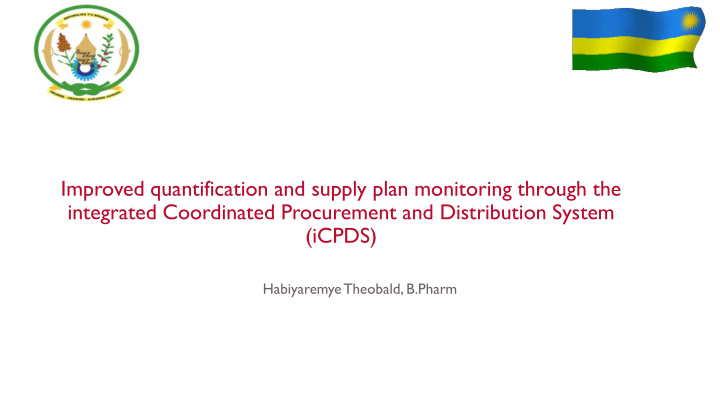



Improved quantification and supply plan monitoring through the integrated Coordinated Procurement and Distribution System (iCPDS) Habiyaremye Theobald, B.Pharm
Background • The Rwanda Ministry of Health has been conducting annual health commodity quantifications since 2004 • The Coordinated Procurement and Distribution System (CPDS) was started with a focus on the HIV program in 2004 • Each public health program was conducting its own quantification at different times and processes were not harmonized across programs • The integrated CPDS ( iCPDS) is an initiative of the Ministry of Health, created in 2017 and implemented with the support from the USAID Global Health Supply Chain Program - Procurement and Supply Management (GHSC-PSM) project • The aim of the iCPDS was to harmonize health program quantifications thereby reducing time needed to conduct quantifications and supply monitoring activities and their associated costs
Objective To discuss how the iCPDS has optimized the quantification processes for all health commodities
Methodology • In 2017, the Ministry of Health in collaboration with supply chain partners came together to develop a mechanism modeled after the CPDS that combined all public health programs • The CPDS governance document was reviewed to harmonize processes and procedures and roles and responsibilities governing the quantification and supply plan monitoring activities for all commodities • CPDS activities were then integrated, coordinated and conducted together following the same processes
Results • The first integrated quantification brought together 40 participants from • Ministry of Health (MOH) and the Rwanda Biomedical Center (RBC) • Partners, Including United Nation (UN) agencies, Society for Family Health (SFH), United States Agency for International Development (USAID) and Center for Disease Control (CDC) • The integrated quantification exercise covering a period of five years was conducted for • HIV/AIDS commodities • Malaria commodities • TB commodities • Contraceptives • Maternal and Child Health commodities (Emergency obstetrical Care, community case management of diarrhea and pneumonia and nutrition) • Other Essential Medicines
Results • Resources were mobilized by MOH through the CPDS Resource Management Committee to procure the identified needs for one year for all commodities • Other key benefits from this new approach includes: • Acquisition and sharing of skills and knowledge by the CPDS quantification committee members • Cost saving on workshop estimated at about $49,000 USD • Reduced the quantification period from 10 weeks to 2 weeks
Conclusion • Quantification and supply plan monitoring through the iCPDS has shown several efficiencies: • Optimized the utilization of available funds, human resources, and time • Improved supply chain staff capacity to meet cross- cutting programmatic goals and targets
Habiyaremye Theobald, B.Pharm Pharmacist in Charge of CPDS Coordination Ministry of Health theobald.habiyaremye@moh.gov.rw
Recommend
More recommend